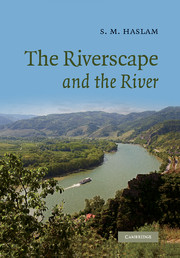Book contents
- Frontmatter
- Contents
- List of tables
- Preface
- Acknowledgements
- 1 Introduction
- 2 The natural river and its destruction
- 3 The natural riverscape and its modification
- 4 Resources I. Water resources and their loss
- 5 Development and variation of rivers
- 6 Development and variation of riverscapes
- 7 Building blocks of river vegetation
- 8 Building blocks of flood plain vegetation
- 9 Resources II. Plants and animals, cleaning and minerals
- 10 Building blocks of the riverscape
- 11 Patterns, boundaries and fragmentation
- 12 Resources III. Settlements and constructions
- 13 The harsh riverscape
- 14 The tempered or smiling riverscape
- 15 Envoi
- Bibliography
- Index to plant and animal vernacular and taxonomic names
- General subject index
8 - Building blocks of flood plain vegetation
Published online by Cambridge University Press: 10 August 2009
- Frontmatter
- Contents
- List of tables
- Preface
- Acknowledgements
- 1 Introduction
- 2 The natural river and its destruction
- 3 The natural riverscape and its modification
- 4 Resources I. Water resources and their loss
- 5 Development and variation of rivers
- 6 Development and variation of riverscapes
- 7 Building blocks of river vegetation
- 8 Building blocks of flood plain vegetation
- 9 Resources II. Plants and animals, cleaning and minerals
- 10 Building blocks of the riverscape
- 11 Patterns, boundaries and fragmentation
- 12 Resources III. Settlements and constructions
- 13 The harsh riverscape
- 14 The tempered or smiling riverscape
- 15 Envoi
- Bibliography
- Index to plant and animal vernacular and taxonomic names
- General subject index
Summary
People are linked to ecology and landscape.
(McFarlane, 1999)Space matters, Mosaics control fluxes of energy, matter and information.
Structural differences lead to functional differences.
(Malanson, 1993)Introduction
Rivers that transport, or used to transport, much sediment, create flood plains: subject to their geomorphology. The plains have (or had) one or more river channels with flowing water, and a greater width over which the water spreads in wet periods, and on which the water drops its sediment, or allows fen peat to grow. Active flood plains are intermediates between river, lake, wetland and dryland. Sedimentation, erosion and currents are all parts of the system, which change over time. Water may be running or standing, perennial or periodic. Overall, these are near-flat over the whole. There may be, however, sharp variations of level (terraces) where flows and land levels have changed in the past, and an earlier flood plain has been eroded and lowered, and this may have happened several times. If water level has risen, the old plain has been covered with new (flood) sediment. There may be lakes, some ox-bows (cut-off meanders). River courses change over time, slowly, or drastically with severe storms. Where there is a flood plain, there is, necessarily, room for a river's course to move. Meanders increase, and are cut off as oxbows, braided courses come and go. Tributaries enter the river at different places. Changes of watercourse lead to changes in flood plains.
- Type
- Chapter
- Information
- The Riverscape and the River , pp. 179 - 216Publisher: Cambridge University PressPrint publication year: 2008



